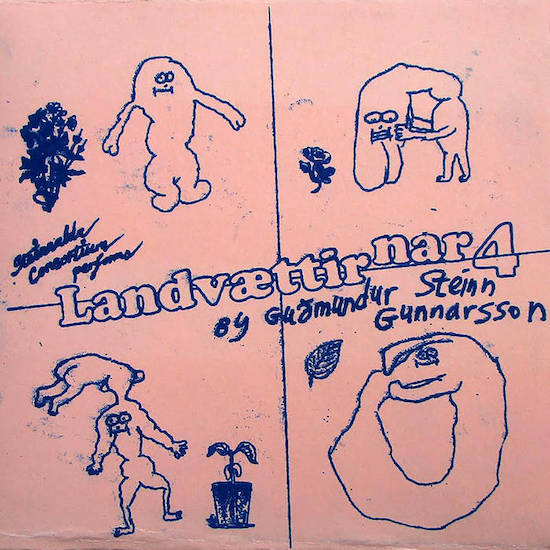Landvættirnar fjórar, by Icelandic composer Guðmundur Steinn Gunnarsson is a sort of concept album comprising twelve pieces based around the mythical ‘land wights’ of Iceland as encountered in the tale of Danish king Haraldur Gormsson in Snorri Sturluson’s sagas. This is pretty dense stuff, and while I’ve read the Prose Edda and the Chronicles of the Icelanders, I’ll confess, I’ve had to do a fair bit of googling to get my head around the story. It’s noteworthy though that these wights, the landvættir, are widely known in Iceland, and even appear on Icelandic money. They manifest as creatures that represent quarters of Iceland or maybe the points of the compass: north, east, south and west, and their true origins are obscure (astrological, elemental, Christian even). Whatever the origin, they are protectors and rich territory for our composer.
Gunnarsson comes from a place of vigorous experimentation and has eschewed metric hierarchy and the constraints of pulse and meter to find a strange and compelling world of rhythms in his music. This approach is abundant here too and taps, clicks and beats run freely and chaotically through this work. I do not mean by that that the work does not feel composed. It is tight, deliberate and beautifully executed by his six-strong ensemble.
Along with the abundant percussion, we hear lots of wind instruments, whistles, recorders, pipes, bird calls and kazoo-like noises and plucked strings throughout, with musicians performing several roles at once. there are also sounds which I can’t quite place that seem a bit like wonky reed organs or tampered with melodicas. I feel certain that there’s nothing here that hasn’t undergone some process of preparation to cope with the microtonal nature of the music. There are occasional chordal gestures, but for the most part we are dealing with discreet single tones intertwining and layering gently around each other. The effect is to feel like one is in the hands of the weather itself.
Tonally, we are not in the realm of equal temperament, and here at least we are better for it. The work feels distinctly animist to me. It is an anthropomorphised geology, the rushing winds over the black, volcanic sands or the disturbance of grasses amid glacial monism. The key perhaps is that the sound world, being mythological, has a non-human feel. It evades easy analysis, and its harmony and scalic structures defy the comfort of western tonal music. It is not without its musical context of course, and you might draw comparison to both Partch and Cage at points, but for me – and I’ll confess to some cognitive bias here – I find myself thinking of the wonderful microtonal compositions of Frank Denyer. This music is denser for sure, and often busier, but it seems to share a fascination with the instability of pitch set against flawlessly placed solid tones. Misleading ostinato forcing the listener to meander through the complex topography of the arrangement.
The whole work is arranged with three movements for each wight. Dreki, the dragon in the east, Gammur, the eagle in the north, Griðungur, the bull in the west and the giant Bergrisi in the south. While the timbral palette remains similar throughout, each section has its own feel and atmosphere, as the wights come from the same place, but each with distinctive character. For example, Gammur has sort of owl hoots around it and the inclusion of plinking toy piano sounds surrounded by creaking drawn out percussion, while Griðungur introduces gently thudding drums reminiscent of the bull’s hooves perhaps.
For all its complexity, the music is both restrained and subtle. It creeps toward you, hushed and slight. There is also humour here, and it’s noteworthy that the notes on the release inform us that every Icelander was encouraged to write a poem of mockery directed at the erstwhile Danish king and would be invader. There are legions of venomous reptiles, flocks of marauding birds, and the giant’s great iron staff all set against the wizard sent by the king to look for vulnerable entry points to the island.
Given the scale of the legends, one might expect a composer to unleash something epic, but Gunnarsson has taken a different tack. This release is one of delicate haunting rather than bombastic fantasy. I for one, am grateful for this approach, which rejects totally the grating and rank Tolkiensim that looms large and bloated in culture. Consider the seductive quarter tones of the closing three pieces as an example of the care and craft on offer here. There is not enough space in a review like this to really get deep into this music, but if you are interested in something contemporary to remove you for a while from both the constraints of equal temperament and meter, and perhaps the dryness of the phenomenal world, then this is very much worth seeking out. At once representational and not. Witty, inventive, unusual and captivating.


